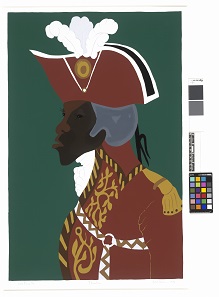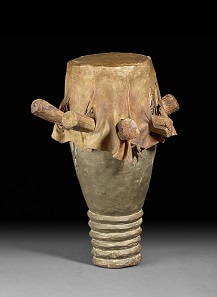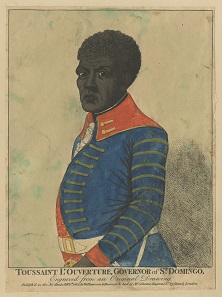March 29, 2018 – The British Museum explores the legacy of the world’s first slave revolution, the Haitian Revolution, which led to the abolition of slavery and the formation of Haiti as an independent republic in 1804 through the Asahi Shimbun display ‘A revolutionary legacy: Haiti and Toussaint Louverture’. This display includes a selection of objects commemorating the man who emerged in the 1790s as the Revolution’s foremost leader: Toussaint Louverture. At the centre of the display will be a new acquisition of an imposing screenprint showing Louverture in military uniform, by the African American artist Jacob Lawrence.
Jacob Lawrence (1917-2000), General Toussaint L’Ouverture from the series The Life of Toussaint L’Ouverture. Screenprint, 1986. © Estate of Jacob Lawrence. ARS, NY and DACS, London 2017.
Specially acquired for this display, Lawrence’s boldly-coloured image of Louverture is the first work by the artist to enter the British Museum’s collection. Artists like Lawrence emerged from the Harlem Renaissance movement in the 1930s which saw the rise of African American culture. The history of Haiti was a touchstone in the struggle for equal rights and anti-racism. Against what he described as the ‘economic slavery’ of African Americans, Lawrence chose to honour Louverture as a powerful leader and the Haitian Revolution as an inspiring story of lasting significance.
Haitian Vodou boula drum. Wood, skin, 500mm x 320mm, early 1900s © the Trustees of the British Museum.
Equally important as an example of continuing injustice for Lawrence’s contemporaries was the US occupation of Haiti from 1915 to 1934. Paired with Lawrence’s print is a Haitian Vodou boula drum (early 1900s), on display for the first time since entering the British Museum’s collection in 1930. Vodou is a diasporic religion with deep roots in West Africa. It played an important role in the Haitian Revolution by uniting diverse groups. During the US occupation, sacred objects like this drum – which during ceremonies would have been whipped with two sticks in a continuous high-pitched rhythm to serve the spirits – were systematically suppressed. However, like Lawrence’s image of Louverture, for which the occupation formed an important context, it remains a poignant symbol of cultural resistance.
Vodou is also central to the work of Haitian-born artist and anthropologist, Gina Ulysse (b. 1966), whose poetic mixing of Vodou chant with words of anti-imperial protest can be heard in the display. Ulysse has been specially commissioned to respond to the display and performed at the British Museum on March 16th. Her voice brings alive the urgency of the Revolution’s message and adds a contemporary layer to the responses across time presented here, including the work of the 18thcentury English poet William Blake, who celebrated slave revolution. Standing alongside Blake’s poetry are heroic representations of Louverture made in London and Edinburgh in 1802.
Banknote for 10 gourdes with portrait of Sanité Bélair. Issued by Haiti. 65 mm x 130 mm, 2004 © the Trustees of the British Museum.
Also on display is a newly-acquired Haitian banknote commemorating the bicentenary of Independence (2004). The banknote depicts Sanité Bélair, a woman who rose to become a lieutenant in Louverture’s army – a forceful reminder of the crucial role played in the Revolution by women, who acted as resistance fighters alongside men.
Commemorative coin. Issued by Senegal. Inscription “Commémoration de l’abolition de l’esclavage” with image of Toussaint L’Ouverture (1743-1803), 2007 © the Trustees of the British Museum.
A Senegalese coin commemorating the abolition of slavery and bearing the profile image of Louverture will also be on display, together with the cover of C. L. R. James’s influential account of the Revolution, Black Jacobins. Written the year Lawrence first created his image of Louverture (1938), and reissued in 1963 during the Civil Rights movement, the message of James’s book, like that of the Revolution itself, has never been more relevant.
Williamson & Parsons, Toussaint L’Ouverture, Governor of St. Domingo. Hand-coloured etching, 330mm x 377mm, 1802 © the Trustees of the British Museum.
Bringing a variety of objects together for the first time, this display highlights the reach of the Haitian Revolution across both time and space. The words on the walls spoken or written by Louverture and other prominent figures highlight that the struggles first begun in Haiti are still crucial in our world today.
The exhibition is on display until April 22, 2018 in the British Museum Room 3.
If you want to learn more about the Asahi Shimbun Displays go to the British Museum website.
For more information on the exhibition go to the British Museums What’s on page.
On Youtube you can watch this short video film on ‘Toussaint Louverture and the Haitian Revolution’.










